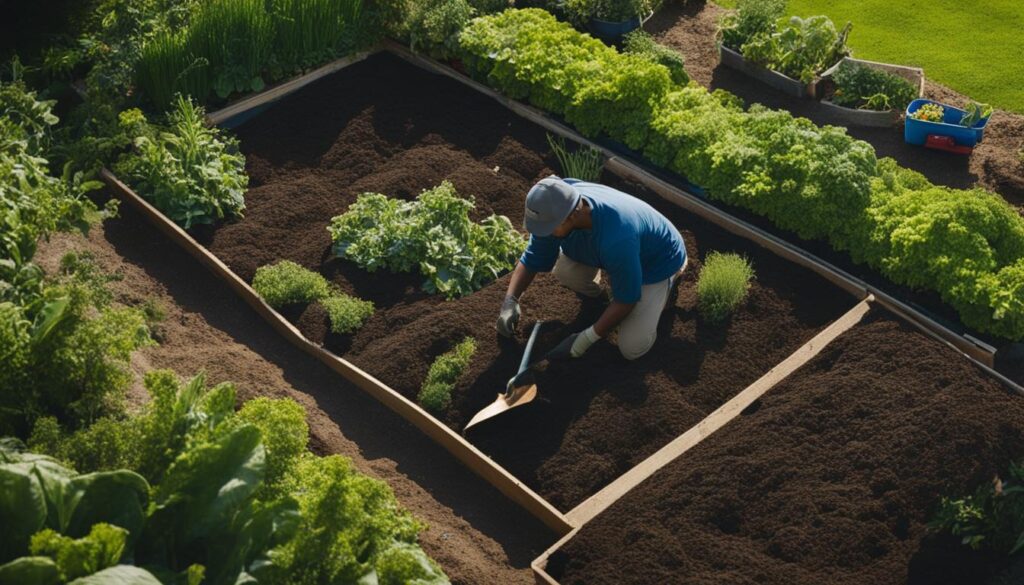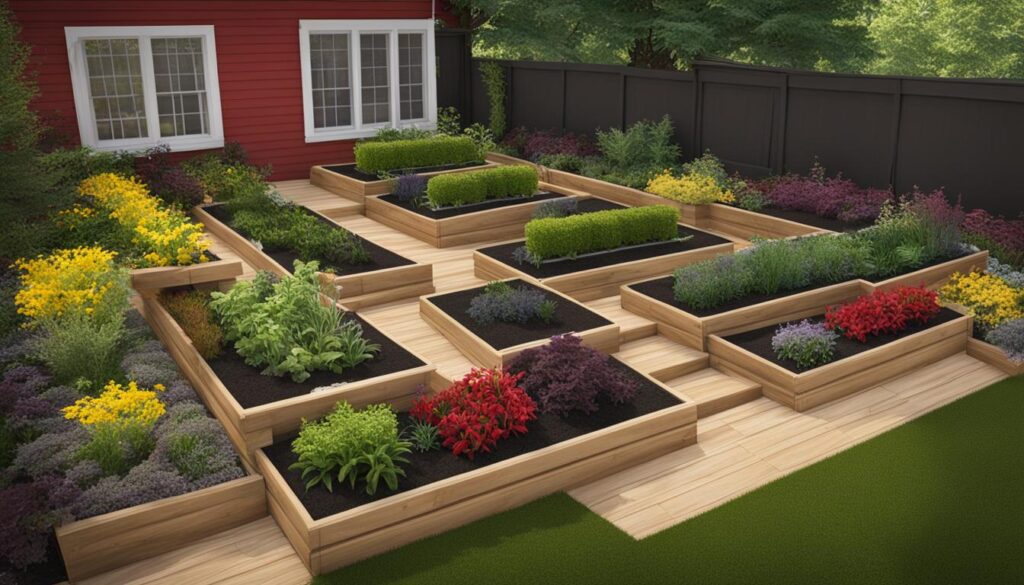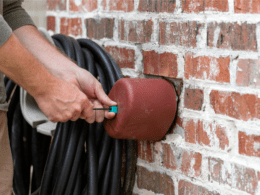Raised garden beds offer various benefits, and determining the ideal depth for a raised garden bed is crucial for successful gardening. The typical depth of a raised garden bed is around 11 inches, which is suitable for most crops. However, the depth can vary depending on factors such as plant root system and personal preferences. It is important to consider drainage, plant root depth requirements, and ease of access when deciding the depth of a raised garden bed.
Post Summary
- The typical depth of a raised garden bed is around 11 inches.
- Depth can vary depending on plant root system and personal preferences.
- Consider drainage, root depth requirements, and ease of access when deciding the depth.
- Proper depth contributes to healthier plants and a more enjoyable gardening experience.
Preparing the Ground for Raised Garden Beds
To ensure optimal plant growth in your raised garden beds, it is crucial to prepare the ground properly before setting them up. Preparing the ground involves a process called “double digging,” which helps create a healthy foundation for your plants. Double digging requires digging the soil to a depth of approximately 24 inches, removing rocks and debris that can hinder root growth and nutrient absorption.
Once you have cleared the top layer of soil, it is important to add soil amendments to improve its quality. Soil amendments such as peat moss, lime, and rock phosphate can help provide essential nutrients and create a fertile environment for your plants. These amendments can also enhance water retention and soil drainage, promoting healthy root development and preventing waterlogged or compacted soil conditions.
Proper soil preparation through double digging and the addition of soil amendments sets the foundation for a successful raised garden bed. By creating an optimal growing environment, you are giving your plants the best chance to thrive and produce abundant harvests.
How Tall Should a Raised Bed Be?
When it comes to determining the height of your raised garden bed, there are a few key factors to consider. The most popular height for raised beds is around 11 inches. This provides a suitable depth for most crops while allowing for proper drainage. However, the ideal height can vary depending on your specific needs and preferences.
If you have mobility issues or experience back strain, a taller raised bed of 18-24 inches may be more suitable. These taller beds reduce the need for bending and kneeling, making it easier to tend to your plants. It’s important to note that taller beds may require additional support to prevent bowing under the weight of the soil.
Accessibility is another important consideration when determining the height of your raised bed. A taller bed of around 24 inches is recommended for wheelchair-friendly gardening. This height allows individuals to comfortably reach and maintain their plants from a seated position, promoting inclusivity and enjoyment of the gardening experience.
Factors to Consider for Raised Bed Height:
- Drainage: The height of the raised bed should allow for proper water drainage to prevent waterlogged soil and potential damage to plant roots.
- Accessibility: Consider your own mobility and any specific needs when deciding on the height of your raised bed. A height that allows for comfortable access and maintenance is essential.
By carefully considering the drainage requirements, accessibility needs, and personal preferences, you can determine the ideal height for your raised garden bed. Whether it’s a standard 11-inch bed, a taller bed for easier maintenance, or an accessible bed for wheelchair-friendly gardening, finding the right height will contribute to the success of your gardening endeavors.
Soil Depth Requirements for Popular Vegetables
When planning a raised garden bed, it’s essential to consider the soil depth requirements of the vegetables you intend to grow. Providing adequate soil depth allows the roots of the plants to establish and grow properly, ensuring optimal growth and productivity. Here are the recommended soil depths for some popular vegetables:
| Vegetable | Root Depth |
|---|---|
| Lettuce | 12-18 inches |
| Herbs | 12-18 inches |
| Peppers | 18-24 inches |
| Cucumbers | 18-24 inches |
| Tomatoes | 24-36 inches |
| Potatoes | 24-36 inches |
These guidelines serve as a general reference for the minimum soil depth required by each vegetable. However, it’s worth noting that deeper soil can provide additional benefits, such as increased moisture retention and better nutrient availability.
By understanding the root depth requirements of different vegetables, you can plan your raised garden bed layout to ensure that each plant has enough room to spread its roots and access the nutrients it needs for healthy growth. Additionally, deeper soil depths can also help ensure stability for taller plants that may need support as they grow.
Where to Place Your Raised Garden Bed
Choosing the right location for your raised garden bed is essential for the success of your plants. It’s important to consider factors such as soil drainage and the type of surface on which the bed will be placed. Proper placement ensures that your plants receive the necessary moisture and nutrients, while also preventing waterlogged soil and soil loss.
Factors to Consider
- Soil Drainage: Before placing your raised garden bed, assess the natural drainage of the area. If the soil beneath the bed can easily exchange moisture with the ground soil, a shallower bed of around 8 inches can be sufficient. However, if the bed will be placed on a solid surface such as concrete or asphalt, it is crucial to ensure proper drainage. In such cases, it is recommended to line the bottom of the bed with gravel or a porous growing medium to balance water content and prevent soil loss.
- Microclimate: Take into account the microclimate of your garden area. Consider factors such as sunlight exposure, wind patterns, and potential shade from nearby structures or trees. These factors can impact the growth and health of your plants, so it’s important to choose a location that provides the optimal conditions for your chosen crops.
- Accessibility: Accessibility is another key consideration when deciding where to place your raised garden bed. Ensure that the location allows for easy access to tend to your plants, harvest produce, and perform maintenance tasks. If you have mobility issues or use a wheelchair, consider a height that allows for comfortable reach without bending or stooping.
By carefully considering these factors, you can select the ideal placement for your raised garden bed. Remember to choose a location that promotes proper soil drainage, takes advantage of the microclimate, and provides easy accessibility. With the right placement, your plants will thrive, and you’ll enjoy a bountiful harvest.
| Crop | Preferred Placement |
|---|---|
| Lettuce | Partial shade, well-drained soil |
| Tomatoes | Full sunlight, well-drained soil |
| Herbs | Partial shade to full sunlight, well-drained soil |
| Peppers | Full sunlight, well-drained soil |
| Cucumbers | Full sunlight, well-drained soil |
Making Accessible Garden Beds
Raised garden beds provide an opportunity for accessible gardening, especially for individuals with limited mobility. By choosing a raised bed height of around 24 inches, gardeners can tend to their plants comfortably without bending or stooping. This height allows for easy access and maintenance from a seated position, making it wheelchair-friendly.
Accessible garden beds can be designed to accommodate the specific needs of individuals while providing an enjoyable gardening experience. The raised bed’s height should be carefully considered to ensure that the gardener can comfortably reach all areas of the bed from a seated position. Additionally, it is essential to leave enough space between the beds to allow for wheelchair maneuverability and easy access.
When designing an accessible garden bed, consider incorporating features such as wider pathways, raised paths, or ramps to improve access for wheelchair users. These features not only provide ease of movement but also contribute to a more inclusive gardening environment. Additionally, using materials such as non-slip surfaces and raised edges can enhance safety and stability for individuals with mobility challenges.
| Accessibility Features | Description |
|---|---|
| Wider Pathways | Ensure there is enough space between garden beds for wheelchair maneuverability. |
| Raised Paths or Ramps | Install raised paths or ramps to improve access for wheelchair users. |
| Non-Slip Surfaces | Choose materials with non-slip surfaces to enhance safety and stability. |
| Raised Edges | Include raised edges to prevent soil from spilling over and provide extra support. |
In conclusion, creating accessible garden beds involves considering the specific needs of individuals with limited mobility. By designing raised beds at a suitable height, incorporating wider pathways, raised paths, non-slip surfaces, and raised edges, gardeners can enjoy the therapeutic benefits of gardening while ensuring a comfortable and inclusive experience for everyone.
Conclusion
In conclusion, the depth of your raised garden bed is a crucial element in creating an optimal gardening environment. By considering factors such as the root depth requirements of your chosen plants, drainage needs, and personal accessibility preferences, you can determine the ideal depth for your raised garden bed.
While the typical depth of 11 inches is suitable for most crops, it’s important to consider the specific needs of your plants. Shallow-rooted vegetables may require a shallower bed, while deep-rooted vegetables necessitate a deeper bed to provide adequate soil depth for their optimal growth.
Additionally, if you have mobility issues or prefer a more comfortable gardening experience, opting for a taller bed of around 24 inches can reduce the need for bending or stooping. This height is particularly beneficial for individuals using wheelchairs, allowing for easy access and maintenance from a seated position.
By carefully considering the depth of your raised garden bed, you can create an optimal growing environment for your plants, leading to healthier and more productive crops. Whether you choose the typical depth or a taller bed, ensuring the right depth will contribute to a more enjoyable and successful gardening experience.
FAQ
What is the typical depth of a raised garden bed?
The typical depth of a raised garden bed is around 11 inches, which is suitable for most crops.
How should I prepare the ground for a raised garden bed?
Before setting up a raised garden bed, it is important to prepare the ground by double digging the soil to a depth of approximately 24 inches to remove rocks and debris and promote root growth. Soil amendments such as peat moss, lime, and rock phosphate can also be added to improve soil quality.
How tall should a raised bed be?
The most popular height for raised beds is around 11 inches, as this allows for sufficient drainage while providing enough soil depth for most crops. However, taller beds of 18-24 inches are recommended for gardeners with mobility issues or back strain, as they reduce the need for bending and kneeling.
What soil depth do different vegetables require in a raised garden bed?
Shallow-rooted vegetables like lettuce and herbs typically need 12-18 inches of soil, while medium-rooted vegetables like peppers and cucumbers require around 18-24 inches. Deep-rooted vegetables like tomatoes and potatoes need 24-36 inches of soil depth.
Where is the best place to put a raised garden bed?
The placement of a raised garden bed depends on the ground soil. If the soil beneath the bed can exchange moisture with the ground soil, a shallower bed of around 8 inches can be sufficient. However, if the bed is placed on a solid surface like concrete, a deeper bed is necessary to ensure proper drainage. In such cases, it is recommended to line the bottom of the bed with gravel or a porous growing medium to balance water content and prevent soil loss.
How can I make a raised garden bed accessible?
To make a raised garden bed accessible, choose a height of around 24 inches. This allows gardeners to tend to their plants comfortably without bending or stooping, making it wheelchair-friendly. Accessible garden beds can be designed to accommodate the specific needs of individuals while providing an enjoyable gardening experience.
How Does the Depth of a Raised Garden Bed Affect Its Benefits?
The depth of a raised garden bed is crucial to explore the benefits of raised garden beds. Deeper beds provide more root space and better drainage, leading to healthier plants. They also require less frequent watering and weeding. A deeper bed allows for a wider variety of plants with different root depths.












